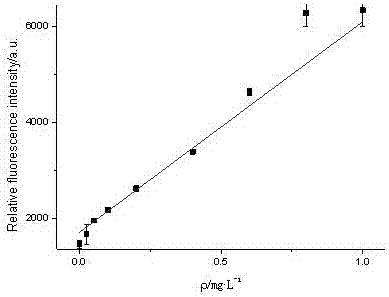Method for detecting phthalate substances in environmental sample
A technology for phthalic acid and environmental samples, which is applied in the field of chemical detection and can solve the problems of high cost and complicated processing
- Summary
- Abstract
- Description
- Claims
- Application Information
AI Technical Summary
Problems solved by technology
Method used
Image
Examples
Embodiment 1
[0016] PAEs determination in the soil sample of embodiment 1
[0017] 1. Extraction of PAEs from samples. Take the 100-mesh soil into conical flasks, 10g in each bottle, add dichloromethane in 3 times (10mL, 5mL, 5mL), extract with ultrasonic vibration for 15min under ice-bath conditions, let stand for 10min, and combine the extracts , passed through anhydrous sodium sulfate column, transferred to a chicken heart bottle, concentrated to near dryness with a rotary evaporator at 40°C, and then reconstituted with 1 mL of absolute ethanol, and each treatment was repeated three times. 2. Fluorescent reaction. Take 4 μL of the above absolute ethanol solution in a 10 mL colorimetric tube, dilute to the mark with 80% concentrated sulfuric acid, mix well, and let stand for 240 min to react. 3. Sample determination. The scanning parameters of the fluorescence spectrometer were set as: excitation wavelength / emission wavelength = 218 nm / 363 nm, photomultiplier tube voltage 700 V, exci...
Embodiment 2
[0020] DnBP recovery rate experiment in embodiment 2 water sample
[0021] 1. Take 25mL of the solution to be tested in a 60mL separatory funnel, add dichloromethane twice (5mL each time), shake manually for 3min (pay attention to outgassing), let it stand for 25min, extract the PAEs in the solution, combine the organic phase, and pass Anhydrous sodium sulfate column, transferred to a chicken heart bottle, evaporated to dryness and concentrated with a rotary evaporator at 40°C, and then reconstituted with 1 mL of absolute ethanol, and each treatment was repeated three times. 2. Fluorescent reaction. Take 4 μL of the above absolute ethanol solution in a 10 mL colorimetric tube, dilute to the mark with 80% concentrated sulfuric acid, mix well, and let stand for 240 min to react. 3. Sample determination. The scanning parameters of the fluorescence spectrometer were set as: excitation wavelength / emission wavelength = 218 nm / 363 nm, photomultiplier tube voltage 700 V, excitation...
PUM
 Login to View More
Login to View More Abstract
Description
Claims
Application Information
 Login to View More
Login to View More - R&D
- Intellectual Property
- Life Sciences
- Materials
- Tech Scout
- Unparalleled Data Quality
- Higher Quality Content
- 60% Fewer Hallucinations
Browse by: Latest US Patents, China's latest patents, Technical Efficacy Thesaurus, Application Domain, Technology Topic, Popular Technical Reports.
© 2025 PatSnap. All rights reserved.Legal|Privacy policy|Modern Slavery Act Transparency Statement|Sitemap|About US| Contact US: help@patsnap.com


